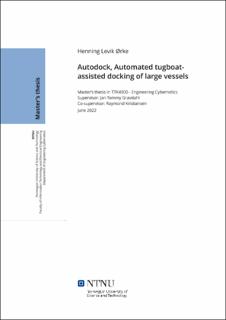| dc.contributor.advisor | Kristiansen, Raymond | |
| dc.contributor.advisor | Gravdahl, Jan Tommy | |
| dc.contributor.author | Ørke, Henning Levik | |
| dc.date.accessioned | 2022-10-01T17:25:46Z | |
| dc.date.available | 2022-10-01T17:25:46Z | |
| dc.date.issued | 2022 | |
| dc.identifier | no.ntnu:inspera:102231297:54806177 | |
| dc.identifier.uri | https://hdl.handle.net/11250/3023120 | |
| dc.description.abstract | Fartøy som trenger slepebåtassistanse for dokking, er vanligvis massive og krever flere slepebåter i en manuelt koordinert operasjon. Mange studier har fokusert på å utvikle avanserte automatiske kontrollsystemer til å kontrollere slepebåter for å manøvrere et stort fartøy, for å automatisere dokking operasjonen. Vanlig praksis blant de tidligere studiene er at slepebåter er i posisjon til å umiddelbart gi de ønskede kreftene. Denne masteroppgaven fokuserer på tidsforsinkelsene som oppstår når slepebåter forflyttes til posisjon for å gi enten skyve- eller trekkrefter, og har som mål å utvikle styrings- og kontrollsystemer for å manøvrere et stort fartøy ved å bruke slepebåter med egen dynamikk som thrustere.
Først ble det utviklet en matematisk modell i Simulink/Matlab ved å implementere fartøysdynamikken for bulkskipet og taubåtene. Slepelinedynamikk og stick-slip-kontaktdynamikk ble implementert for å simulere interaksjonskreftene mellom fartøyene. Deretter ble kontrollsystemet utviklet for taubåtene med flere lineære og ikke-lineære kontrollere for å komme i posisjon og gi de ønskede kreftene, ved å bruke Stateflow-logikk til å bytte mellom dem, og kontrollallokering for å finne de nødvendige retningsbestemte asimutkraftkreftene. Til slutt ble kontroll- og styresystemer utviklet for å kontrollere slepebåtoperasjonen, ved å bruke Stateflow-logikk til å aktivere kontrollsystemet når slepebåtene er i posisjon for å kompensere for tidsforsinkelsene.
Simuleringsresultater viser akseptabel ytelse ved å bruke slepebåter med egen dynamikk som thrustere. Den matematiske modellen har plausibel dynamikk som belyser visse problemer som må vurderes når kontroll- og styresystemer utvikles. Resultatene viser også begrensninger for kontrollsystemet til slepebåtene i operasjoner med økt hastighet, mens løsningene for å håndtere tidsforsinkelsen var sårbare for små endringer. Mer arbeid er nødvendig for å lage en mer realistisk modell, mens kontroll- og styresystemer bør utvikles for å håndtere vær og hydrodynamiske krefter i havner. | |
| dc.description.abstract | Vessels in need of tugboats assistance for docking are usually massive and require multiple tugboats in a manually coordinated operation. Many studies have focused on developing advanced automatic control solutions for controlling tugboats to manoeuvre a large vessel, for automating the docking operation. The common practice among the prior studies is that tugboats are in position to immediately give the desired forces. This thesis focuses on the time delays required to move tugboats in position to provide either pushing or pulling forces and aims to develop guidance and control systems to manoeuvre a large vessel by using tugboats with their own dynamics as thrusters.
First, a mathematical model was developed in Simulink/Matlab by implementing the bulk carrier and tugboat vessel dynamics. Towline dynamics and stick-slip contact dynamics were implemented to simulate the interaction forces between the vessels. Then, the tugboat control systems were developed with several linear and non-linear control laws to get in position and give the desired forces, by using Stateflow logic to switch between them, and control allocation to solve for the necessary directional azimuth thrust forces. Finally, control and guidance systems were developed to control the tugboat operation, by using Stateflow logic to activate the control system when tugboats are in position to compensate for the time delays.
Simulation results show reasonable performance of using tugboats with their own dynamics as thrusters. The mathematical model has plausible dynamics that enlightened certain problems that must be considered when developing guidance and control systems. The results also show limitations for the tugboat control system in operations with increased velocities, while the solutions to handle the time delay was vulnerable to small changes. More work is necessary to create a more realistic model, while control and guidance systems should be developed to handle weather and hydrodynamical forces in harbours. | |
| dc.language | eng | |
| dc.publisher | NTNU | |
| dc.title | Autodock, Automated tugboat-assisted docking of large vessels | |
| dc.type | Master thesis | |
